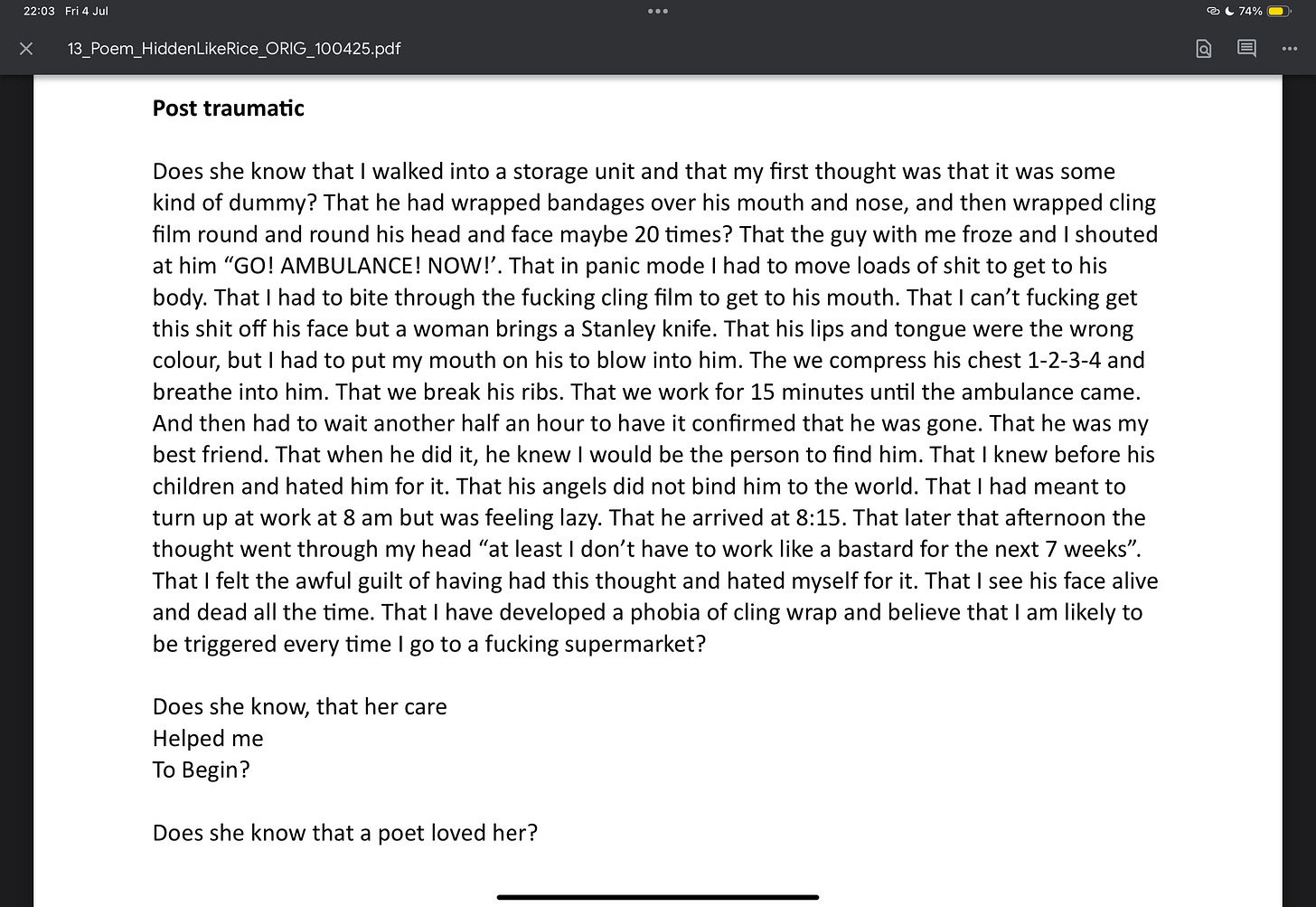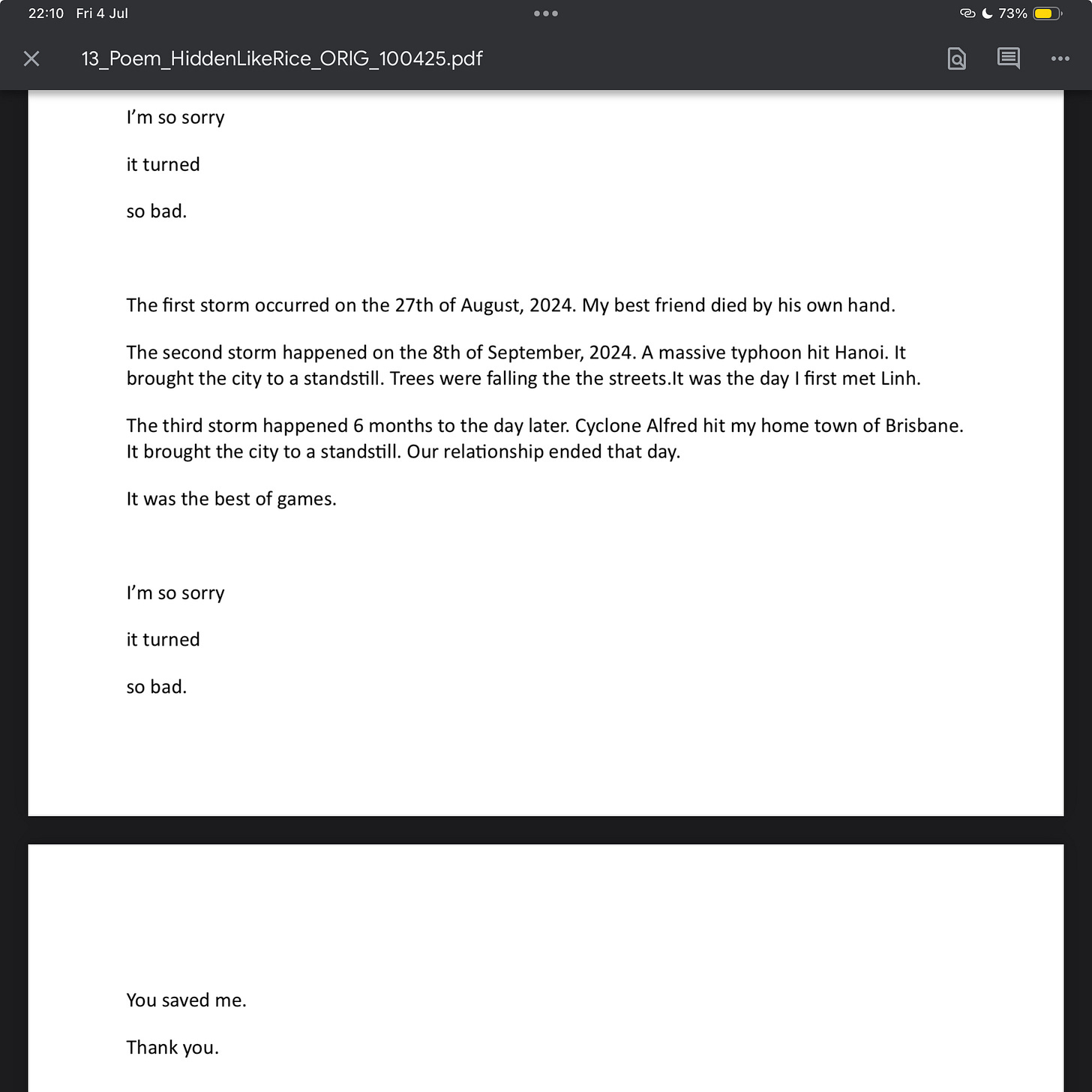Pathos — the emotional appeal in rhetoric — is traditionally considered one of the three pillars of classical persuasion, alongside ethos (credibility) and logos (logic). When used appropriately, pathos can touch audiences deeply, evoke empathy or outrage, and deliver a powerful message. But when overused, it stops being a tool of connection and turns into a weapon of manipulation.
Grief as Hook
In the latest “email-art piece” sent by Johnston — ironically titled Hidden Like Rice — we witness an intricate tapestry of pathos so meticulously woven that it almost demands applause for its sheer manipulative craftsmanship. Almost.
The piece starts with an extended lament about his best friend’s suicide. We are given graphic details: cling film wrapped around the head, broken ribs during CPR, color of lips, the “dirty bomb” of grief.
This is grief pathos at its most visceral. It is not about sharing to heal — it is about hooking the reader into a pit of despair so deep that they feel morally obligated to stay and console. It positions Johnston as the tragic hero who carries unbearable loss, creating a power imbalance from the start: “I suffer, therefore you owe me comfort.”
Written without consent. Screenshot retained for documentation purposes. Originally authored by Pat Johnston.
Self-Pity as Armor
Intertwined with grief is an elaborate web of self-pity. We read confessions like “I hated myself for it,” or “I felt the awful guilt of thinking I wouldn’t have to work so hard.”
These admissions sound raw — but in context, they serve to preempt accountability. When someone broadcasts their “weakness” repeatedly, it stops being vulnerability and becomes armor. If you criticize or resist them, you become the cruel one. It absolves the sender of responsibility, while subtly shifting emotional labor onto the recipient.
Erotic Vulnerability as Bait
After building the scaffolding of grief and pity, Johnston pivots into explicit eroticism. Here, Linh is transformed into “small Linh,” “tiny breasts,” “flat belly,” “hidden like rice.” The repeated references to her physical smallness, her supposed fragility — combined with his own older, “damaged” self — create a narrative of protective eroticism.
The sexual pathos is not meant to celebrate connection. Rather, it functions as bait: merging compassion with desire, fusing pity with submission. In this fusion, emotional boundaries dissolve. The reader is made to believe that comforting him necessarily includes erotic closeness.
Written without consent. Screenshot retained for documentation purposes. Originally authored by Pat Johnston.
Guilt-Tripping as Closure
Finally, we arrive at the guilt-laden refrains: “I’m so sorry it turned so bad,” “It was the best of love stories,” “You saved me.”
These repeated lines serve to lock in the guilt: if you step away, you abandon not just a man, but a tragic, poetic universe. You cease being a savior. You become the betrayer.
Written without consent. Screenshot retained for documentation purposes. Originally authored by Pat Johnston.
The Symphony of Pathos
When grief, self-pity, erotic vulnerability, and guilt-tripping are played together, they form a symphony of pathos. In this piece, the intended listener is manipulated to feel responsible for his healing, seduced into intimate caretaking, and guilted into perpetual emotional service.
It is not a love letter. It is not a poem. It is a script — designed to control the narrative and recruit the recipient as an emotional hostage.
Echoes of Amber Heard
Image Credit: The Central Trend
The Amber Heard and Johnny Depp trial offered a global-scale demonstration of pathos misuse. Heard heavily leaned on emotional overload: tears, vivid recollections, dramatic pauses. The aim: to move the public, to awaken protective instincts toward a “victim.”
However, when pushed to the point of “emotional overdose,” pathos backfires. The public began to notice inconsistencies: crying followed by laughter, overly detailed narratives, conflicting accounts. This internal contradiction severely undermined her credibility.
In behavioral psychology, this is called emotional flooding — overwhelming the audience with excessive emotion to the point of numbness or active resistance. When the audience stops believing in authenticity, pathos turns into a double-edged sword. And this pattern doesn’t just play out on global stages — it appears in small, private arenas too.
Reflections from this thread
I used to think pathos was simply a tool to write more beautifully. But after witnessing personal stories — especially when someone used a 16,000-word “poetic essay” to justify harmful behaviors, then blaming pain, religion, children, and personal loss — I realized:
“The loudest cries are not always the most truthful.”
Those who truly own their stories usually don’t need to flood. They speak concisely, directly, and allow their words to be verified.
As a researcher (albeit an unexpected one), I realized that “academic integrity” is not just about plagiarism. It’s also about how you use emotion and personal truths.
You may “write about love,” but when you embed enough details for a real person to recognize themselves — and then deny their identity — it is no longer poetry. It is symbolic retaliation.
Amber Heard’s case is a large-scale example, but even smaller, “niche” stories on Substack illustrate this clearly:
Pathos abuse = emotional power abuse = forfeiting the right to define the truth.
Conclusion
Pathos is not inherently bad. But when misused, it is a knife that cuts into the user’s own credibility.
Amber Heard may continue to exist in media, but the image of the “perfect victim” has collapsed. And across all cultures, East or West, when pathos is overused, audiences will eventually see the line between real and fabricated. In the end, no narrative trick can outrun the collective sense of truth.
When “poetry” stops being poetry and starts becoming an emotional hostage negotiation.
Publications for reference:
- Entry 4: Hidden Like Accountability
- Entry 13: QUT and The Man Who Raped Me
- Entry 38: When Poetry Becomes Revenge Porn
Update (June 10, 2025): Counter-Takedown Filed — Fair Use & Survivor-Led Documentation
On June 9, I received a formal DMCA notice from Google informing me that Patrick Johnston had submitted a copyright takedown request targeting my publicly accessible survivor evidence folders documentation already submitted to QPS as part of police evidence.
This content, previously submitted to law enforcement in the context of unwanted contact and coercive behavior, cannot retroactively be reframed as protected intellectual property for the purpose of silencing survivor documentation.
Any takedown request targeting such material constitutes a strategic misuse of copyright law, not a legitimate rights claim.
These files were published strictly under academic Fair Use and Fair Dealing protections, as part of an ethics-based documentation series. This takedown is not a valid copyright dispute, but a coercive response to institutional criticism.
Attempts to assert copyright over police-submitted evidence constitute a serious ethical and potentially legal breach. Such actions may be interpreted as obstruction of justice and retaliation against protected reporting
This is not copyright protection. This is reputational panic, disguised as a takedown notice.
The content was non-commercial, already submitted to Queensland Police (QPS) and regulators under official case IDs. Its removal constitutes an attempt to suppress documented harms rather than enforce legitimate rights. Misusing copyright mechanisms in this manner may qualify as a form of strategic litigation against public participation (SLAPP).
My publication falls squarely within the thresholds of:
Australian Copyright Act 1968 – Sections 41 & 42 (Fair Dealing)
U.S. Copyright Law – §107 (Fair Use)
International norms protecting public interest commentary and trauma documentation.
I have submitted a formal counter-notice. As per standard procedure, Google has forwarded the takedown request to the Lumen Database, where it is now publicly visible as part of platform transparency archives.
View takedown request on Lumen
If harassment persists, I reserve the right to escalate this matter to ethics boards, international legal monitors, and public interest watchdogs tracking strategic censorship and retaliatory misuse of institutional tools.
Any misuse of personal information obtained via counter-notice or takedown responses will be treated as further coercive harassment and may be reported to law enforcement under digital harm and privacy abuse frameworks.
No individual has the right to suppress survivor-led documentation solely on the basis of personal discomfort — especially when such material pertains to evidence already submitted to law enforcement.
Note on Naming:
The individual named in this piece is referenced due to the public nature and severity of their documented behavior, including threats and retaliatory writings.
The purpose of naming is not humiliation, but record integrity. When public responses fail to address the core evidence presented, transparency remains necessary.
Naming in this context reflects a duty to document — not to defame. Selective rebuttal does not equate to accountability.
Full evidence archive submitted to QPS, TEQSA, AHRC and Ethics Australia: View here.
Read the full series
- Entry 1: The Man Who Taught Me Ethics by Failing All of Them
- Entry 2: The Disappearance of the Public Poet
- Entry 3: The Hanging Tree Case Study
- Entry 4: Hidden Like Accountability
- Entry 5: The Collapse of Assumptions
- Entry 6: The Ethics of a Tinder Bio
- Entry 7: How He Ate Told Me Everything
- Entry 8: What Makes a Scholar Dangerous
- Entry 9: Fragment of Life, Fragment of Accountability
- Entry 10: Anatomy of Disappointment
- Entry 11: Legal Defense Challenges: A Framing Statement
- Entry 12: Six Years After Ronell – What Academia Still Doesn’t Get
- Entry 13: QUT and The Man Who Raped Me
- Entry 14: Why Sarcasm Toward Institutions Can Backfire
- Entry 15: P*ssy or Toxic Masculinity?
- Entry 16: Who is Your Favorite Comedian?
- Entry 17: And What is Your Favorite Song?
- Entry 18: Grant Proposal — Narrative Ethics as Survivor-Led Forensics
- Entry 19: The Coward Behind the Clone
- Entry 20: [URGENT HIRE] CRISIS COMMUNICATIONS SPECIALIST
- Entry 21: [URGENT] Legal Counsel Needed for Complex Reputation Rehabilitation
- Entry 22: YOU’RE AN ABUSER. STOP CONTACTING ME
- Entry 23: Seeking Counsel for a Fallen Academic
- Entry 24: Internal Legal-PR Briefing
- Entry 25: For Journalists – Legal & Ethical Clearance Summary
- Entry 26: Symbolic Prostitution, Transactional Intimacy, or Just a “Loan”?
- Entry 28: Why He Simply Cannot Shut Up
- Entry 29: Forensic Commentary on “LARGE Language Muddle”
- Entry 30: Don’t Just Threaten My Future. Because I’m Going To Archive Your Present
- Entry 31: Open Letter to the Person Who Tried to Break Me with Defamation
- Entry 32: Defamation, Harassment, Doxxing Class 101
- Entry 33: Confidential Crisis Recovery Proposal
- Entry 34: Forensic Behavioral-Somatic Report
- Entry 35: Forensic Commentary on the Tattoos
- Entry 36: QUT and the Abuser They Once Had
- Entry 38: When Poetry Becomes Revenge Porn
- Entry 40: A Man Built for Applause, Not Accountability
- Entry 41: Neurobehavioral Addendum
- Entry 42: Pathos Overuse (you are here)
- Entry 43: Why Does It Sound Like a War Metaphor?
- Entry 44: Forensic Commentary on Racialized and Fetishizing Language in “Hidden Like Rice”
- Entry 45: Public Misuse of Former Academic Affiliation
- Entry 46: The Two Things That Didn’t Leave a Bad Impression
- Entry 47: When Affection is Just an Alibi (A Bundy-Inspired Reflection)
- Entry 48: Humbert, Lolita, and the Fetish of Fragility
- Entry 49: The Fetish of Smallness as Symbolic Violence
- Entry 50: Motif Risk Analysis
- Entry 52: Can an Abuser Be a Good Father?
- Entry 53: Who Protects the Children?
- Entry 54: From Blackmail to Children
- Entry 55: A Letter I’ll Never Send
- Entry 56: Outc(L)assed - Critical Race Analysis
- Entry 57: Forensic Breakdown: “A Voidance” by Johnston
- Entry 58: Johnston, Who Raised You?
- Entry 59: Public Financial Terms & Narrative Conditions
- Entry 60: What Kind of Future Do You Think Awaits You?
- Entry 61: Why I Believe He Has No Real PR or Legal Team
- Entry 62: Why I Can Legally (and Ethically) Call You a Pathetic Pig
- Entry 63: Tell Me You’re a Pathetic Pig Without Telling Me You’re a Pathetic Pig
- Entry 65: Did Your Mother Teach You To Speak Like This?
- Entry 66: Nobody Cares Anyway
- Reflection: The Miscalculation
(More entries coming soon)
→ [Back to Start: Introducing Mr. J, a Former Professor Series]
© 2025 Linh Ng. All rights reserved.
This publication is intended for educational and reflective purposes only.
Sharing the original link is welcomed and encouraged.
Please do not reproduce, redistribute, or translate this content — in whole or in part — without written permission.
This piece reflects both lived experience and critical analysis. It is not meant to be detached from its author or reframed without context.
Misuse or decontextualization may lead to formal clarification or takedown requests.
This work has been reviewed and quietly followed by scholars, educators, and ethics professionals across multiple sectors.
If your institution is engaging in critical discourse around narrative justice, symbolic coercion, or representational ethics, feel free to connect via Substack DMs or formal channels.
A regulatory case regarding this matter has already been classified under a protected status within national education integrity systems.
Should any reputational countermeasures or distortions arise, I reserve the right to publish the documented timeline, behavioral patterns, and contextual metadata.
All relevant documentation has been submitted through formal legal and regulatory pathways.








